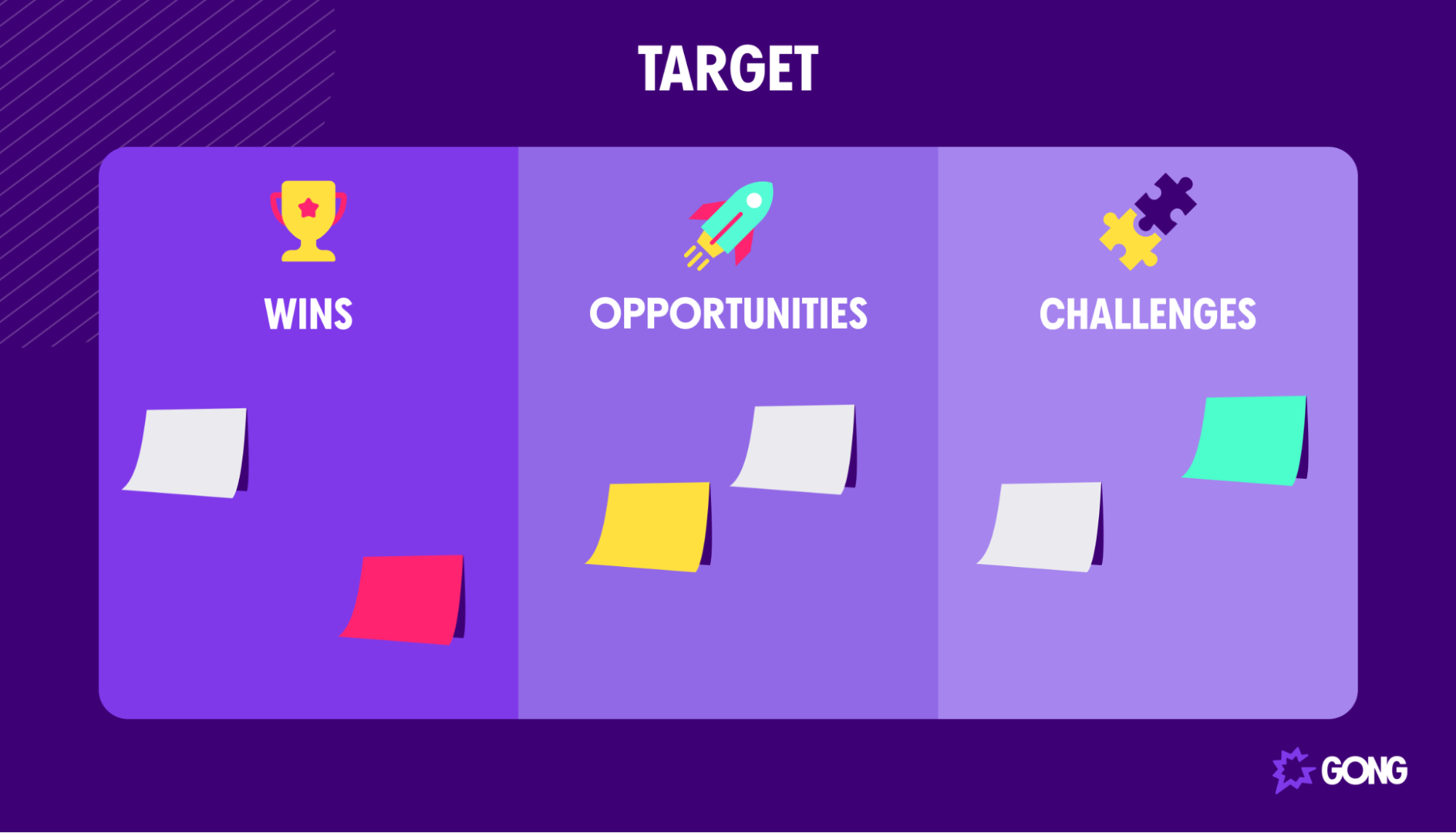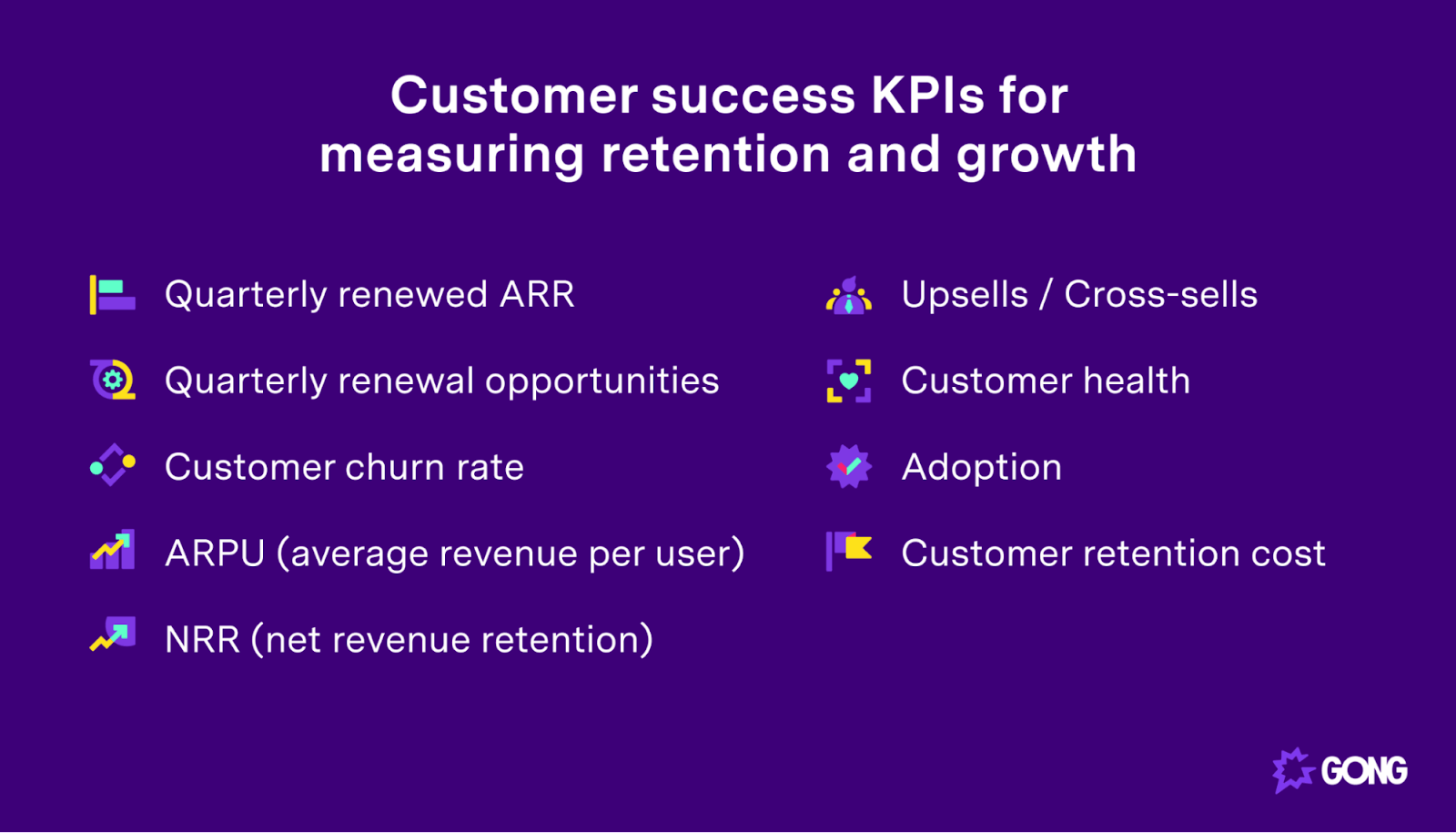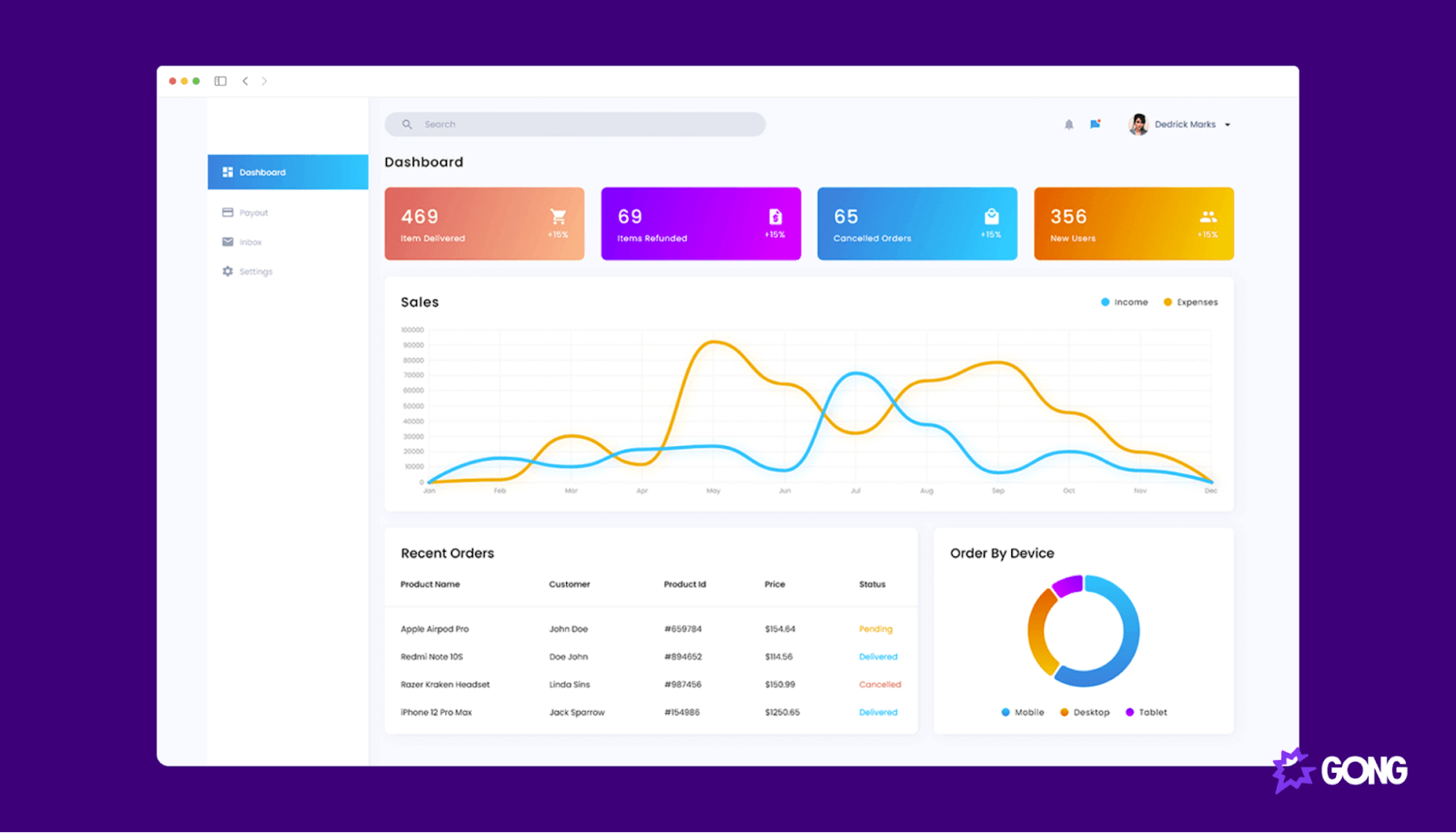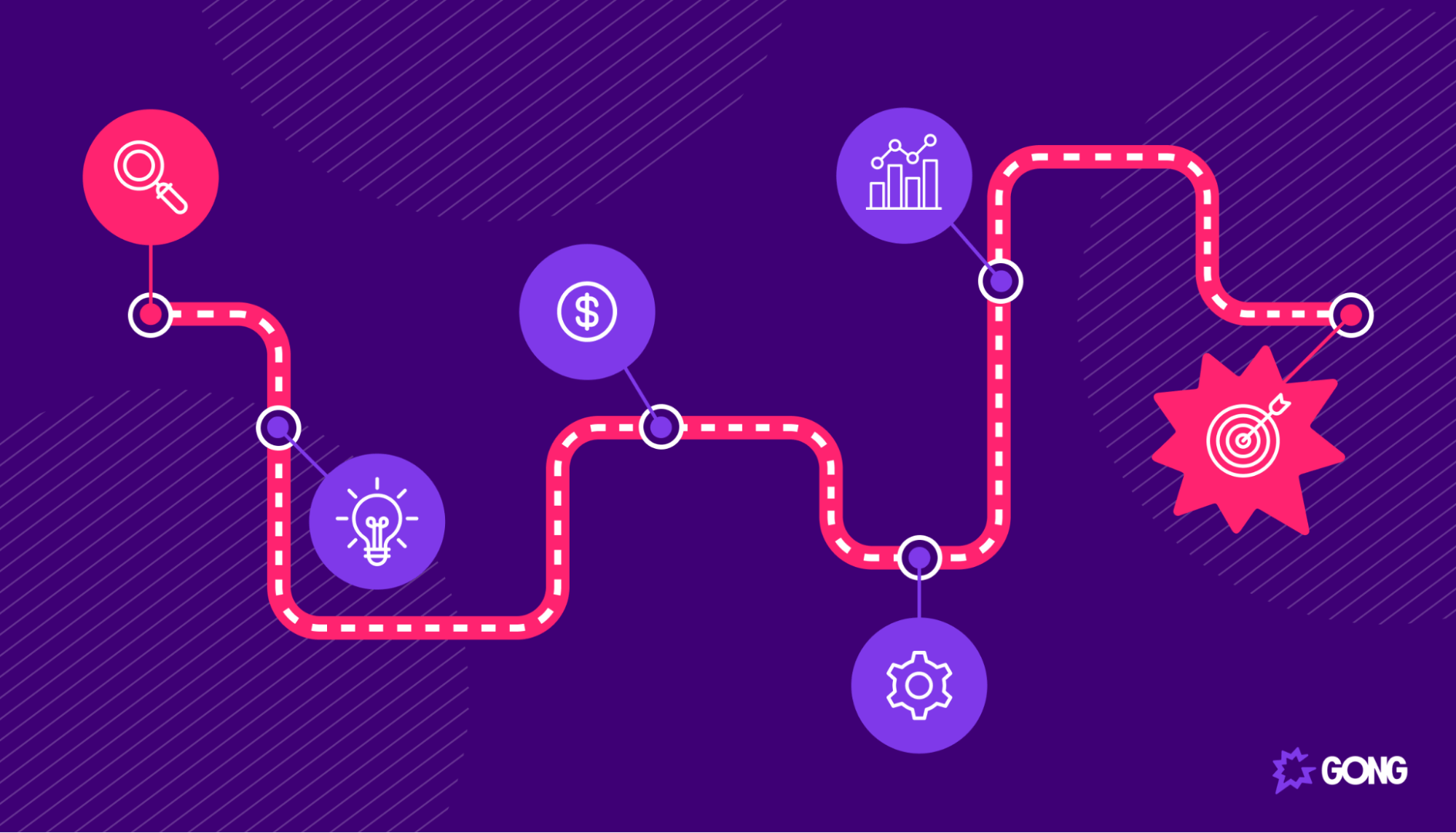How to avoid the 9 mistakes that sink quarterly business reviews

Your quarterly business review (QBR) presentation is an opportunity to reflect on how well your current strategies meet your buyer’s business goals.
If your business review presentation isn’t clear, to the point, and goal-oriented, your buyers will leave the meeting unsure about whether your services are improving their bottom line.
Here are the top reasons you’re struggling to convey your reflections clearly, along with presentation tips and best practices to upgrade your QBRs.
9 missteps in your QBR presentations (and how to fix them)
Your QBR presentation is a great opportunity for business growth.
Make your business review count this upcoming quarter by avoiding these traps.
1. You try to target everything, but lack focus
Your quarterly executive business review should be concise, direct, and focused on specific business goals.
Speak too broadly, and you risk your presentation sounding like a high-level rundown. Explain every little detail, and you won’t have time to cover what matters.
Pick the key goals and concentrate on progress over the quarter.
Reiterate what you’re working toward, the steps you’ve taken, and how those strategies have played out. Then use this information to suggest your next steps.
Find QBR presentation examples or a good business review template that can help organize your thoughts. Not only can a presentation template help order your points, but it’ll also make it easier to create a fitting presentation design that visually illustrates what you’re saying.
Remember, don’t get distracted by tangents. Stick to an agenda to keep your QBR on track and take questions at the end.
2. You have bad news, but you’re not upfront
It can be tempting to sugarcoat or gloss over anything that’s been unsuccessful. But, it’s important to be upfront and discuss the context.
You’re not here to read your buyers a success story. A business review presentation is an opportunity to critically analyze your progress and agree on an action plan for the next quarter.
If you’ve got bad news, rip off the bandaid. This honesty nurtures trust and invites everyone in the meeting to brainstorm solutions.
Don’t say: “This quarter we’ve been testing an adventurous marketing strategy and we’re starting to see emerging patterns that steer us away from previous ideas toward a more fruitful future.”
Do say: “The marketing strategy we tested this quarter wasn’t as successful as we’d hoped. The data shows that we misjudged campaign timings, so potential buyers went to our competitors. Taking this new information into account, our plan for next quarter is to use HubSpot to do XYZ.”
3. You’re reflective, but not conclusive
While it’s important to explain your tactics, you need to draw conclusions for future campaigns. Focus on wins, challenges, and opportunities.
Try doing a SWOT analysis to give an objective insight into the strengths, weaknesses, opportunities, and threats (SWOT).
For example, let’s say your buyer wants to increase their sales.
Your Facebook advertising campaign led to more sales (strength), but the website kept crashing due to over-capacity (weakness).
Upcoming revenue from the influx of new buyers means you can funnel funds into upgrading your website to cope with higher traffic (opportunity). But, you’ll need to scale your customer success department or risk being overwhelmed by support calls (threat).
4. You measure a lot of KPIs, but can’t identify the best ones
While data and analytics are important, it’s easy to get carried away with too many key performance indicators (KPIs).
It’s better to have a handful of KPIs that your buyers will understand explicitly, rather than having so many that they get lost in the data.
Pick the KPIs that show a clear picture of how you’re defining the success of your strategies.
As a customer retention example, you might use tools to measure:
- Churn rate
- Net revenue retention
- Upsells and cross sells
- Retention cost
- Customer health
- Customer success metrics
Your buyers don’t need to hear all the figures. They just want to know how churn is affecting their profits.
So, you only pick customer churn rate and net revenue retention to show how many buyers you’re losing and how it impacts the bottom line.
5. You talk about progress, but don’t contextualize it
While you don’t want to ramble on or make excuses, it’s important to contextualize your progress, both good and bad.
There are many internal and external factors that impact campaign success, from economic and political issues to company restructuring. A tactic could fail because you made a poor hiring decision or because there was an unexpected global pandemic.
Contextualizing your progress helps you to understand the reason for your results. Not only does this help traverse these issues in the future, but it also shows you how to leverage similar landscapes to benefit from the context.
As an example, take Virgin Pulse.
Even amid economic uncertainty, their sales team is thriving. They’ve recently increased top-of-the-funnel conversions by 400%.
By using Gong to listen in to sales meetings, they’ve identified common trends that led to successful deals, despite the negative economic factors. Highlighting common discussion topics, questions, action items, and relationship dynamics, Gong shows sales managers what buyers need in real time.
So, if they see buyers are worried about high prices during future periods of economic downturn, they know to offer promotions when people are tightening their belts.
6. You explain your findings, but don’t use real data in your QBR slides
Real data gives credibility to your findings. It proves that your strategies are working as they say they are and enables you to drill down into how you’re succeeding.
Rather than simply pointing out which campaigns were successful, solid data can help illustrate the factors that have affected your progress, when, and how.
Plus, it’s easier to explain your results concisely with hard numbers.
Remember though, nobody wants to hear someone drone on about numbers.
Visuals and infographics make your QBR presentation design more engaging and easier to understand. Add data visualizations to your presentation deck to help everyone conceptualize the data.
7. You offer solutions, but they’re not specific
While you don’t need to reinvent the wheel, your strategies should fit your buyers.
The strategies you choose need to align with your buyer’s goals. But, beyond that, they should fit the firm’s resource capacity, target persona, business model, and operating style.
When you design solutions, take a deep dive into these aspects of the buyer’s operations to better tailor your ideas.
After all, it’s no use building a TikTok campaign for a company that targets senior citizens.
Just look at Addepar.
While they could have recycled many of their previous strategies to improve sales effectiveness, they chose to delve into their buyer personas.
Using Gong’s Deal Insights tool to analyze buyer interaction data, the wealth management platform can now devise extremely specific, highly-impactful sales tactics.
For example, every account manager now encourages prospects to invite another member of their team into the sales pitch call because it significantly increases the chance of conversion.
This very niche solution might not work for every company, but it works for Addepar because it’s founded on their exact target persona.
8. You design strategies, but fail to involve the people on the ground
Don’t fall into the trap of thinking you have all the answers.
Just because you’ve seen a hiccup like this before, doesn’t mean you know how to solve it too. If you’re only drawing conclusions from data and your own experience, you might miss key day-to-day factors affecting your success plan.
For example, imagine that your buyer wants to improve bottom-of-the-funnel conversions.
Looking at the KPIs, you notice most buyers drop out when asked to enter personal data. You incorrectly conclude that you’re asking for too much information.
However, that’s not the problem.
After talking to the technical support team, it’s clear the bugs in the onboarding process are affecting customer experience. Your time, efforts, and resources would be better spent improving the customer journey.
Reach out to the people on the ground. If you’re building sales strategies, talk to sales managers. If you’re trying to improve the customer success program, speak with the customer success team. Leveraging employees provides you with a big source of real-world data.
Try using Gong to analyze these interactions so you can find common themes between teams and pinpoint valuable insights from the people working with your strategies every day.
9. You summarize well, but forget a roadmap slide
While it’s a quarterly business review, it’s important to use these reflections to look toward the future.
By unpacking what works and what doesn’t, you now have the building blocks to craft goal-oriented, actionable next steps for the upcoming quarter.
On top of that, you’ve also learned lessons that could impact your future trajectory.
For example, you may have found a new technology to help you develop your product twice as quickly as expected. While you planned to dedicate the next quarter to development, you now have to adjust your product roadmap to move into the next stage.
Upgrade your roadmap with updated next steps and timescales, taking into account the reflections and lessons from the past quarter.
Leverage interactions to improve your QBR pitch decks
A quarterly business review presentation isn’t just an opportunity to reflect on last quarter’s progress. It’s a chance to show what works and what doesn’t, so that you can adjust your strategic plan for the next quarter.
It shouldn’t be a diatribe.
Use a quarterly business review template or sample QBR presentation to help organize your thoughts, so you keep every client meeting brief, customer-specific, and goal-centric. Add infographics to clarify data and a roadmap slide to contextualize future actions.
Don’t forget to harness customer and team interactions to help you understand the context of your progress and the main areas for improvement. Get a demo of Gong today to help you gain valuable insights to shape your business review presentations.






